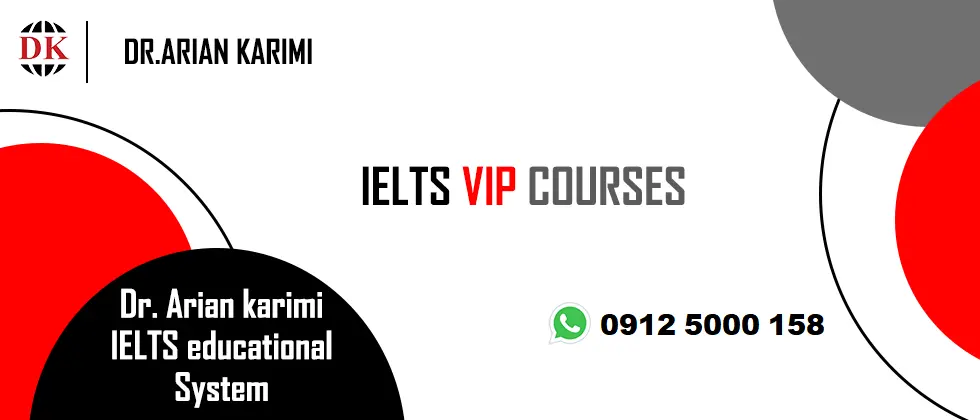Online IELTS Course with Dr. Arian Karimi from Iran
with an Innovative IELTS Teaching Methodology
Online IELTS TOEFL CELPIP Course in Norooz 98
Many first time teachers and those who haven’t taught IELTS often shudder in fear at the first mention of the acronym.
Most view it as a highly technical aspect of ESL
teaching of an exam that they would probably fail if they took the exam! That couldn’t be further from the truth. Yes, IELTS is a highly technical exam that rewards students with a higher score for those who adhere to structure. But by learning a few tips and tricks about the exam and methods to help the students, you will give help your students move in the right direction when it comes to getting the required grade they need, and provide them while building your own skills in teaching it at the same time. Teachers should also remember that specialist ESL subjects, such as IELTS, TOEFL and TOEIC often pay a lot higher than general English, so EFLer’s who want to make a bit of extra cash should take some time out and jump in the deep end when it comes to teaching international exam preparation.
How to Teach IELTS
1 Show them what they’re in for!
At the beginning of the course, in order to give them a taste of what they’re aiming for, start with a practice exam. This demonstrates the structure, timing implication and the serious nature of study that they need to undertake until the time of their exam. You should tell the students that IELTS is no walk in the park, and if they seriously want to improve their score, then they really need to put in the effort and knuckle down to get the grade they desire. Students should also be given honest feedback as to what their levels are. Don’t give them false hope. If the student is at a basic level, don’t promise them a 6.5 IELTS grade. Be honest with them. IELTS examiners say that the average improvement for a typical student who studies on a regular basis will achieve an increase of 0.5 for every six months of studying.
2 Focus on their weak points
After the practice test, you should have a good idea of their weak points. The IELTS test is broken down into four parts: reading, speaking, listening and writing. While you should be teaching all aspects of the test, focus on the weak points of the students and provide them with extra activities. Bring it all the way back to basics for them if need be, and get them writing simple sentences if they make simple errors.
3 Structure, structure, structure!
One of the great things about teaching IELTS is that most of the questions are similar, and even though they increase in level of difficulty throughout, they can all be written to a structure. With the writing tasks, ensure that students include all the necessary information in an essay, such as thesis statement, topic sentences, supporting ideas, well-constructed paragraphs and a conclusion with no new information. Achieving this formula is the half-way point to achieving a decent score. For writing, one of our favourite tasks is what we call a ‘Mini-Essay’. A Mini-Essay builds the students skills by focusing on the structure rather than the overall content. The student must write an introduction, body paragraph and a conclusion. This can be done towards the end of an IELTS class and the students can read out their answers.
4 Timing is everything!
After students have learnt the structure of the questions, it is important that they learn to complete the tasks within the set time limits. As the questions in the reading become more difficult, the students should spend an increasing length of time on the questions. For example, the IELTS reading task contains three passages that become increasingly difficult. Instead of spending 20 minutes on each, they should spend 15 minutes on the first, 20 on the second and 25 minutes on the third.
5 PPP – Plan, Produce, Proof
Plan, Produce, Proof - these are the keys to the writing section. Students must be made aware of the structural implications that their work has on their overall IELTS score. By planning, the student will lessen the risk of writing any word that pops into their mind and sticking to a structure as set out in the plan. Proof reading is also important, as students will lose marks on silly grammar and spelling errors – one easy way to lose marks.
6 Listening tricks and tips
Well, not strictly cheat codes, but some methods to help the students with the listening. Students can look ahead at the questions during the 1 minute and 30 second gap in the listening exercises. This should give the students a brief outline of what they are listening out for, such as the topic and the possible vocabulary involved. This should enable the students to use their power of prediction. Also with the listening, the students should listen out very carefully to ‘misspoken’ words. An example of this is where the day, date or location is corrected by the speaker. For example, the speaker may say ‘So, we shall meet on Tuesday, oh no.. Wednesday’. Students need to be careful to put the correct information down, as sometimes they are distracted by the first answer and don’t hear the correction.



